Multiple Sclerosis
Multiple sclerosis (MS), also known as disseminated sclerosis or disseminated encephalomyelitis, is a demyelinating disease in which the insulating covers of nerve cells in the brain and spinal cord are damaged. This damage disrupts the ability of parts of the nervous system to communicate resulting in a wide range of signs and symptoms including physical, mental, and sometimes psychiatric problems. MS takes several forms with new symptoms either occurring in isolated attacks (relapsing) or building up over time (progressive). Between attacks, symptoms may disappear completely; however, permanent neurological problems often occur, especially as the disease progresses.
While the cause is not clear, the underlying mechanism is thought to be either destruction of the immune system or a failure of the myelin-producing cells. [5] Proposed causes for this include genetics and environmental factors such as infections. MS is usually diagnosed based on presented signs and symptoms and the results of supporting medical tests.
There is no known cure for multiple sclerosis. Treatments attempt to improve function after an attack and prevent new attacks. Medications used to treat MS, while modestly effective, can have adverse effects and be poorly tolerated. Many people pursue alternative treatments despite a lack of evidence. The long-term outcome is difficult to predict, with good outcomes more often seen in women, in patients who develop the disease early in life, those with a relapsing course and those who initially experienced few attacks. Life expectancy is on average 5 to 10 years lower than that of the unaffected population.
Multiple sclerosis is the most common autoimmune disorder affecting the central nervous system. As of 2008, between 2 and 2.5 million people are affected globally with rates varying widely in different regions of the world and among different populations. In 2013, 20,000 people died from MS up from 12,000 in 1990. The disease usually begins between the ages of 20 and 50 and is twice as common in women as in men. The name multiple sclerosis refers to scars (or “sclerae” better known as plaques or lesions) in particular in the white matter of the brain and spinal cord. Jean-Martin Charcot first described MS in 1868. A number of new treatments and diagnostic methods are under development.
New Research papers published by Saisei Mirai
Case Report: GcMAF Treatment in a Patient with Multiple Sclerosis
ANTICANCER RESEARCH 36: 3771-3774 (2016)
Signs and Symptoms
Multiple Sclerosis Signs and Symptoms
A person with MS can have almost any neurological symptom or sign, with autonomic, visual, motor and sensory problems being the most common. The specific symptoms are determined by the locations of the lesions within the nervous system and may include loss of sensitivity or changes in sensation such as tingling, pins and needles or numbness, muscle weakness, very pronounced reflexes, muscle spasms or difficulty in moving; difficulties with coordination and balance (ataxia); problems with speech or swallowing, visual problems (nystagmus, optic neuritis or double vision), feeling tired, acute or chronic pain and bladder and bowel difficulties, among others. Difficulties thinking and emotional problems such as depression or unstable mood are also common. Uhthoff’s Phenomenon, a worsening of symptoms due to exposure to higher than usual temperatures, and Lhermitte’s Sign, an electrical sensation that runs down the back when bending the neck, are particularly characteristic of MS. The main measure of disability and severity is the expanded disability status scale (EDSS) with other measures such as the multiple sclerosis functional composite being increasingly used in research.
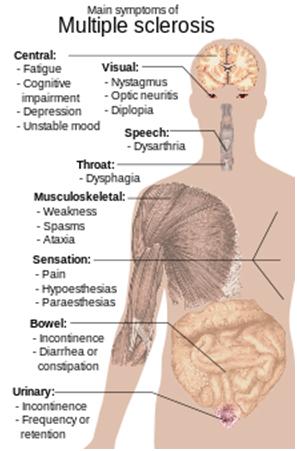
The condition begins in 85% of cases as a clinically isolated syndrome over a number of days with 45% having motor or sensory problems, 20% having optic neuritis and 10% having symptoms related to brainstem dysfunction while the remaining 25% have more than one of the previous difficulties. The course of symptoms occurs in two main patterns initially: either as episodes of sudden worsening that last a few days to months (called relapses, exacerbations, bouts, attacks or flare-ups) followed by improvement (85% of cases) or as a gradual worsening over time without periods of recovery (10-15% of cases). A combination of these two patterns may also occur or people may start in a relapsing and remitting course that then becomes progressive later on. Relapses are usually not predictable, occurring without warning. Exacerbations rarely occur more frequently than twice a year. Some relapses, however, are preceded by common triggers and they occur more frequently during spring and summer. Similarly, viral infections such as the common cold, influenza or gastroenteritis increase their risk. Stress may also trigger an attack. Women with MS who become pregnant experience fewer relapses; however, during the first months after delivery the risk increases. Overall, pregnancy does not seem to influence long-term disability. Many events have not been found to affect relapse rates including vaccination, breast-feeding, physical trauma and Uhthoff’s phenomenon.
Causes
The cause of MS is unknown; however, it is believed to occur as a result of some combination of genetic and environmental factors such as infectious agents. Theories try to combine the data into likely explanations but none has proved definitive. While there is a number of environmental risk factors, some of which are partly modifiable, further research is needed to determine whether their elimination can prevent MS.
Geography
MS is more common in people who live farther from the equator although exceptions exist. These exceptions include ethnic groups that are at low risk far from the equator such as the Samis, Amerindians, Canadian Hutterites, New Zealand Māori and Canada’s Inuit, as well as groups that have a relatively high risk close to the equator such as Sardinians, inland Sicilians, Palestinians and Parsis. The cause of this geographical pattern is not clear. While the north-south gradient of incidence is decreasing, as of 2010 it is still present. MS is more common in regions with northern European populations whereby the geographic variation may simply reflect the global distribution of these high-risk populations. Decreased sunlight exposure resulting in decreased vitamin D production has also been put forward as an explanation. A relationship between the season of birth and MS lends support to this idea as fewer people born in the northern hemisphere in November as compared to May are affected later in life. Environmental factors may play a role during childhood with several studies finding that people who move to a different region of the world before the age of 15 acquire the new region’s risk to MS. If migration takes place after age 15, however, the person retains the risk of their place of origin. There is some evidence that the effect of moving may still apply to people older than 15.
Genetics
HLA region of Chromosome 6. Changes in this area increase the probability of getting MS.
MS is not considered a hereditary disease; however, a number of genetic variations have been shown to increase the risk. The probability is higher in relatives of an affected person, with a greater risk among those more closely related. In identical twins both are affected about 30% of the time, while around 5% for non-identical twins and 2.5% of siblings are affected, with a lower percentage for half-siblings. If both parents are affected, the risk in their children is 10 times that of the general population. MS is also more common in some ethnic groups than others.
Specific genes that have been linked with MS include differences in the human leukocyte antigen (HLA) system – a group of genes on chromosome 6 that serves as the major histocompatibility complex (MHC).
That changes in the HLA region are related to susceptibility has been known since the 1980s; this same region has also been implicated in the development of other autoimmune diseases such as diabetes type I and systemic lupus erythematosus. The most consistent finding is the association between multiple sclerosis and alleles of MHC defined as DR15 and DQ6. Other loci have shown a protective effect such as HLA-C554 and HLA-DRB1*11. Overall, it is estimated that HLA changes account for between 20 and 60% of genetic predisposition. Modern genetic methods (genome-wide association studies) have discovered at least twelve other genes outside the HLA locus that modestly increase the probability of MS.
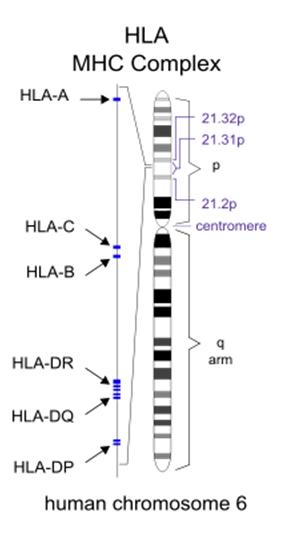
Infectious Agents
Many microbes have been proposed as triggers of MS but none have been confirmed. Moving at an early age from one location in the world to another alters a person’s subsequent risk of MS. An explanation for this could be that some kind of infection, produced by a widespread microbe rather than a rare one, is related to the disease. Proposed mechanisms include the hygiene hypothesis and the prevalence hypothesis. The hygiene hypothesis proposes that exposure to certain infectious agents early in life is protective, the disease being a response to a late encounter with such agents. The prevalence hypothesis proposes that the disease is due to an infectious agent more common in regions where MS is common and that in most individuals it causes an ongoing infection without symptoms. Only in a few cases and after many years does it cause demyelination. The hygiene hypothesis has received more support than the prevalence hypothesis.
Evidence for a virus as a cause include: the presence of oligoclonal bands in the brain and cerebrospinal fluid of most people with MS, the association of several viruses with human demyelination encephalomyelitis and the occurrence of demyelination in animals caused by viral infection. Human herpes viruses are a candidate group of viruses. Individuals having never been infected by the Epstein–Barr virus are at a reduced risk of getting MS whereas those infected as young adults are at a greater risk than those having had the condition at a younger age. Although some consider this to contradict the hygiene hypothesis, since the non-infected probably experienced a more hygienic upbringing, others believe that there is no contradiction since it is a first encounter with the causative virus relatively late in life that triggers the disease.
Other diseases that may be related include measles, mumps and rubella.
Miscellaneous
Smoking has been shown to be an independent risk factor for MS. Stress may be a risk factor although the evidence to support this is weak. Association with occupational exposures and toxins, mainly solvents, has been evaluated but no clear conclusions have been reached. Vaccinations were studied as causal factors; however, most studies show no association. Several other possible risk factors, such as diet and hormone intake, have been looked at; however, evidence on their relation with the disease is “sparse and unpersuasive”. Gout occurs less than expected and lower levels of uric acid have been found in people with MS. This has led to the theory that uric acid is protective although its exact importance remains unknown.
Pathophysiology
Pathophysiology of multiple sclerosis
The three main characteristics of MS are the formation of lesions in the central nervous system (also called plaques), inflammation and the destruction of the myelin sheaths of neurons. These features interact in a complex and not yet fully understood manner to produce the breakdown of nerve tissue and in turn the signs and symptoms of the disease. Additionally, MS is believed to be an immune-mediated disorder that develops from an interaction of the individual’s genetics and as yet unidentified environmental causes. Damage is believed to be caused, at least in part, by an attack on the nervous system by a person’s own immune system.
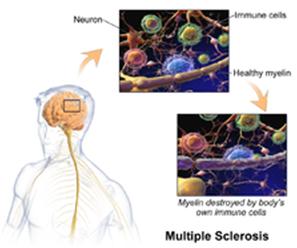
Multiple Sclerosis in Animation
Lesions
The name multiple sclerosis refers to the scars (sclerae – better known as plaques or lesions) that form in the nervous system. These lesions most commonly affect the white matter in the optic nerve, brain stem, basal ganglia and spinal cord or white matter tracts close to the lateral ventricles. The function of white matter cells is to carry signals between grey matter areas, where processing takes place and the rest of the body. The peripheral nervous system is rarely involved.

To be specific, MS involves the loss of oligodendrocytes, the cells responsible for creating and maintaining a fatty layer – known as the myelin sheath – which helps the neurons carry electrical signals (action potentials). This result in a thinning or complete loss of myelin and as the disease advances, the breakdown of neuron axons. When the myelin is lost, a neuron can no longer effectively conduct electrical signals. A repair process, called remyelination, takes place in the early phases of the disease but the oligodendrocytes are unable to completely rebuild the cell’s myelin sheath. Repeated attacks lead to successively less effective remyelinations until a scar-like plaque is built up around the damaged axons. These scars are the origin of the symptoms and during an attack magnetic resonance imaging (MRI) often shows more than ten new plaques. This could indicate that there are a number of lesions below which the brain is capable of repairing itself without producing noticeable consequences. Another process involved in the creation of lesions is an abnormal increase in the number of astrocytes due to the destruction of nearby neurons. A number of lesion patterns have been described.
Inflammation
Apart from demyelination, the other sign of the disease is inflammation. Fitting with an immunological explanation, the inflammatory process is caused by T cells, a kind of lymphocyte, which play an important role in the body’s defense.
T cells gain entry into the brain via disruptions in the blood–brain barrier. The T cells recognize myelin as foreign and attack it explaining why these cells are also called “auto-reactive lymphocytes”.
The attack of myelin starts an inflammatory process which triggers other immune cells and the release of soluble factors like cytokines and antibodies. Further breakdown of the blood–brain barrier in turn causes a number of other damaging effects such as swelling, activation of macrophages and more activation of cytokines and other destructive proteins. Inflammation can potentially reduce transmission of information between neurons in at least three ways. The soluble factors released may stop neurotransmission by intact neurons. These factors could lead to or enhance the loss of myelin or they may cause the axon to break down completely.
Blood–Brain Barrier
The blood–brain barrier is a part of the capillary system that prevents the entry of T cells into the central nervous system. It may become permeable to these types of cells secondary to an infection by a virus or bacteria. After it repairs itself, typically once the infection has cleared, T cells may remain trapped inside the brain. Gadolinium cannot cross a normal BBB and, therefore, gadolinium-enhanced MRI is used to show BBB breakdowns.
Diagnosis
Multiple sclerosis is typically diagnosed based on present signs and symptoms, in combination with supporting medical imaging and laboratory testing. It can be difficult to confirm, especially early on, since the signs and symptoms may be similar to those of numerous other medical conditions. The McDonald criteria which focus on clinical, laboratory and radiologic evidence of lesions at different times and in different areas are most commonly used in diagnosis with the Schumacher and Poser criteria now being mostly of historical significance. While the above criteria allow for a non-invasive diagnosis, some state that the only definitive proof is an autopsy or biopsy by which typical MS lesions are detected.
Clinical data alone may be sufficient for a diagnosis of MS if an individual has had separate episodes of neurological symptoms characteristic of the disease. In patients seeking medical attention after only one attack, other testing is needed for a diagnosis. The most commonly used diagnostic tools are neuroimaging, analysis of cerebrospinal fluid and evoked potentials. Magnetic resonance imaging of the brain and spine may show areas of demyelination (lesions or plaques). Gadolinium can be administered intravenously as a contrast agent to highlight active plaques and, by elimination, demonstrate the existence of historical lesions not associated with symptoms at the time of evaluation. [41][43] Testing of cerebrospinal fluid obtained by lumbar puncture can provide evidence of chronic inflammation in the central nervous system. The cerebrospinal fluid is tested for oligoclonal bands of IgG on electrophoresis which are inflammation markers found in 75–85% of patients with MS. The nervous system in MS may respond less actively to stimulation of the optic nerve and sensory nerves due to the demyelination of such pathways. These brain responses can be examined using visual- and sensory-evoked potentials.
Clinical Course
Several phenotypes (commonly named types) or patterns of progression have been described. Phenotypes use the past course of the disease in an attempt to predict the future course.
They are important not only for prognosis but also for treatment decisions. In 1996, the United States National Multiple Sclerosis Society described four clinical courses. This set of courses was later reviewed by an international panel in 2013, adding clinically isolated syndrome (CIS) and radiologically isolated syndrome (RIS) as phenotypes but leaving the main structure unchanged.
- Relapsing-remitting (RRMS)
- Secondary progressive (SPMS)
- Primary progressive (PPMS)
- Progressive relapsing
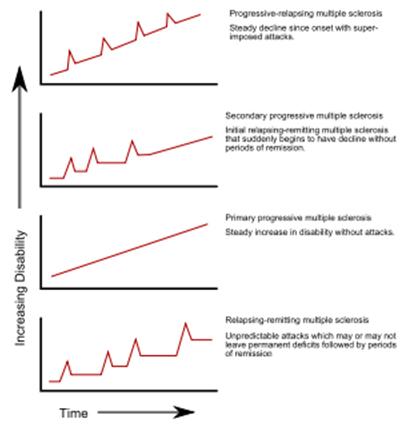
Progression of MS subtypes
The relapsing-remitting subtype is characterized by unpredictable relapses followed by periods of months to years of relative quiet (remission) with no new signs of disease activity. Deficits that occur during attacks may either resolve or leave problems, the latter in about 40% of attacks and being more common the longer a patient has had the disease. This describes the initial course of 80% of individuals with MS. When deficits always resolve between attacks, this is sometimes referred to as benign MS, although such patients will still build up some degree of disability in the long term. On the other hand, the term malignant multiple sclerosis is used to describe people with MS having reached significant level of disability in a short period. The relapsing-remitting subtype usually begins with a clinically isolated syndrome (CIS). In CIS, a person has an attack suggestive of demyelination but does not meet the criteria for multiple sclerosis. 30 to 70% of persons experiencing CIS later develop MS.
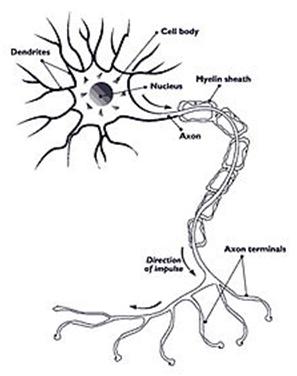
Secondary progressive MS occurs in around 65% of those with initial relapsing-remitting MS who eventually have progressive neurologic decline between acute attacks without any definite periods of remission. Occasional relapses and minor remissions may appear. The most common length of time between disease onset and conversion from relapsing-remitting to secondary progressive MS is 19 years.
The primary progressive subtype occurs in approximately 10–20% of patients with no remission after the initial symptoms. It is characterized by a progression of disability from the onset with no or only occasional and minor, remissions and improvements.
The usual age of onset for the primary progressive subtype is later than the relapsing-remitting subtype. It is similar to the age that secondary progressive usually begins in relapsing-remitting MS at around 40 years of age.
Progressive relapsing MS describes those individuals who, from onset, have a steady neurologic decline but also have clear superimposed attacks. This is the least common of all subtypes.
Unusual types of MS have been described; these include Devic’s Disease, Balo Concentric Sclerosis, Schilder’s Diffuse Sclerosis and the Marburg Multiple Sclerosis. There is a debate on whether these are MS variants or different diseases.
Multiple sclerosis behaves differently in children, taking more time to reach the progressive stage. Nevertheless, they still reach it at a lower average age than adults usually do.
Management
Although there is no known cure for multiple sclerosis, several therapies have proven helpful. The primary aims of therapy are returning functionality after an attack, preventing new attacks as well as disability. As with any medical treatment, medications used in the management of MS have several adverse effects. Alternative treatments are pursued by some people despite the shortage of supporting evidence.
Acute Attacks
During symptomatic attacks, administration of high doses of intravenous corticosteroids, such as methylprednisolone, is the usual therapy, with oral corticosteroids seeming to have a similar efficacy and safety profile. Although, in general, effective in the short term for relieving symptoms, corticosteroid treatments do not appear to have a significant impact on long-term recovery. The consequences of a severe attack that does not respond to corticosteroids may be treatable by plasmapheresis.
Disease-Modifying Treatments
Relapsing Remitting Multiple Sclerosis
As of 2014, nine disease-modifying treatments have been approved by regulatory agencies for relapsing-remitting multiple sclerosis (RRMS) including: interferon beta-1a, interferon beta-1b, glatiramer acetate, mitoxantrone, natalizumab, fingolimod, teriflunomide, dimethyl fumarateandalemtuzumab. Their cost effectiveness as of 2012 is unclear.
In RRMS, they are modestly effective at decreasing the number of attacks. The interferons and glatiramer acetate are first-line treatments and are roughly equivalent, reducing relapses by approximately 30%. Early-initiated long-term therapy is safe and improves outcomes. Natalizumab reduces the relapse rate more than first-line agents; however, due to problems with adverse effects, it is a second-line agent reserved for those who do not respond to other treatments or with a severe case of the disease.
Mitoxantrone whose use is limited by severe adverse effects is a third-line option for those who do not respond to other medications. Treatment of clinically isolated syndrome (CIS) with interferons decreases the chance of progressing to clinical MS. Efficacy of interferons and glatiramer acetate in children has been estimated to be roughly equivalent to that of adults. The role of some newer agents such as fingolimod, teriflunomide and dimethyl fumarate as of 2011 is not yet entirely clear.
Progressive Multiple Sclerosis
No treatment has been shown to change the course of primary progressive MS and as of 2011 only one medication, mitoxantrone, has been approved for secondary progressive MS. In this population, tentative evidence supports mitoxantrone moderately slowing the progression of the disease and decreasing rates of relapses over two years.
Adverse Effects
Disease-modifying treatments have several adverse effects. One of the most common is irritation at the injection site of glatiramer acetate and interferons (up to 90% with subcutaneous injections and 33% with intramuscular injections). Over time, a visible dent at the injection site due to the local destruction of fat tissue, known as lipoatrophy, may develop. Interferons may produce flu-like symptoms; some people taking glatiramer experience a post-injection reaction with flushing, chest tightness, heart palpitations and anxiety which usually lasts less than thirty minutes. More dangerous but much less common are liver damage from interferons, systolic dysfunction (12%), infertility and acute myeloid leukemia (0.8%) from mitoxantrone as well as progressive multifocal leukoencephalopathy occurring with natalizumab (in 1 in 600 people treated).
Fingolimod may give rise to hypertension and a slowed heart rate, macular edema, elevated liver enzymes or a reduction in lymphocyte levels. Tentative evidence supports the short-term safety of teriflunomide, with common side effects including: headaches, fatigue, nausea, hair loss and limb pain.
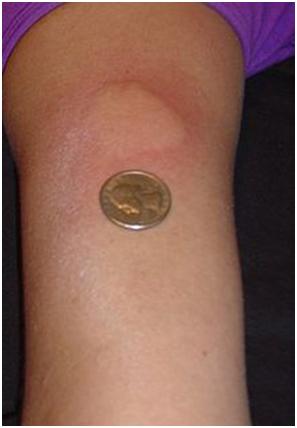
Irritation Zone After Injection of Glatiramer Acetate
Prognosis
Disability-adjusted life year for multiple sclerosis per 100,000 inhabitants in 2004.

The expected future course of the disease depends on the subtype of the disease; the individual’s gender, age and initial symptoms; and the degree of disability the person has. Female gender, relapsing-remitting subtype, optic neuritis or sensory symptoms at onset, few attacks in the initial years and especially early age at onset, are associated with a better course.
The average life expectancy is 30 years from the start of the disease, which is 5 to 10 years less than that of unaffected people. Almost 40% of people with MS reach their 70s. Nevertheless, two-thirds of the deaths are directly related to the consequences of the disease. Suicide is more common while infections and other complications are especially dangerous for the more disabled. Although most people lose the ability to walk before death, 90% are capable of walking independently 10 years from onset and 75% at 15 years thereafter.
Epidemiology
MS is the most common autoimmune disorder of the central nervous system. As of 2010, the number of people with MS was 2–2.5 million (approximately 30 per 100,000) globally with rates varying widely in different regions. MS is estimated to have resulted in 18,000 deaths that year. In Africa rates are less than 0.5 per 100,000, being significantly higher in South East Asia at 2.8 per 100,000, 8.3 per 100,000 in the Americas and 8.0 per 100,000 in Europe. Rates surpass 200 per 100,000 in certain populations of Northern European descent. The number of new cases that develop per year is about 2.5 per 100,000.
Rates of MS appear to be increasing; this, however, may be explained simply by better diagnosis. Studies on population AL and geographical patterns are common and have led to a number of theories about the cause.
MS usually appears in adults in their late twenties or early thirties but it can rarely start in childhood and after 50 years of age. The primary progressive subtype is more common in people in their fifties. Similar to many autoimmune disorders, the disease is more common in women. This trend may be increasing. As of 2008, it is about two times more common in women than in men globally. In children, it is even more common in females than males while in their 50s, MS affects males and females almost equally.
History
Medical Discovery
The French neurologist Jean-Martin Charcot (1825–1893) was the first person to recognize multiple sclerosis as a distinct disease in 1868. Summarizing previous reports and adding his own clinical and pathological observations, Charcot called the disease scleroseen plaques. The three signs of MS now known as Charcot’s triad 1 are nystagmus, intention tremor and telegraphic speech (scanning speech) though these are not unique to MS. Charcot also observed cognition changes, describing his patients as having a “marked enfeeblement of the memory” and “conceptions that formed slowly”.

Detail of Carswell’s Drawing of MS Lesions in Brain Stem and Spinal Cord
Medications
There is ongoing research looking for more effective, convenient and tolerable treatments for relapsing-remitting MS; creation of therapies for the progressive subtypes; neuroprotection strategies; and effective symptomatic treatments.
During the 2000s and 2010s, there has been approval of several oral drugs expected to gain in popularity and frequency of use. Several more oral drugs are under investigation including ozanimod and laquinimod. Laquinimod was announced in August 2012 and presently is in Phase III trials after mixed results in the previous ones. [105] Similarly, studies aimed to improve the efficacy and ease of use of already existing therapies are being undertaken. This includes the use of new preparations such as the PEGylated version of interferon-?-1a which is hoped may be administered at less frequent doses with similar effect.
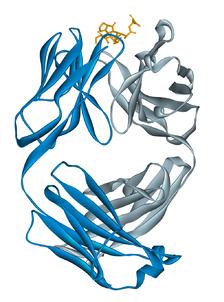
Chemical Structure of Alemtuzumab
Request for approval of peginterferon beta-1a is expected during 2013.
Monoclonal antibodies have also raised high levels of interest. Alemtuzumab, daclizumab and CD20 monoclonal antibodies such as rituximab, ocrelizumab and ofatumumab have all shown some benefit and are under study for potential treatments. Their use has also been accompanied by the appearance of potentially dangerous adverse effects, opportunistic infections being the most important among them. Related to these investigations is the development of a test for JC virus antibodies, which might help to determine who is at greater risk of developing progressive multifocal leukoencephalopathy when taking natalizumab. While monoclonal antibodies will probably have some role in the treatment of the disease in the future, it is believed that it will be small due to the associated risks.
Another research strategy is to evaluate the combined effectiveness of two or more drugs. The main rationale for using a number of medications in MS is that the treatments involved target different mechanisms and thus their use is not necessarily exclusive. Synergies in which one drug improves the effect of another are also possible but there can also be drawbacks such as the blocking of the action of one by the other, or side effects generally. There have been several trials of combined therapy yet no results were positive enough to be considered a useful treatment for MS.
Research on neuroprotection and regenerative treatments, such as stem cell therapy, while of high importance, are in the early stages. Likewise, there are no effective treatments for the progressive variants of the disease. Many of the newest drugs as well as those under development are probably going to be evaluated as therapies for PPMS or SPMS.













